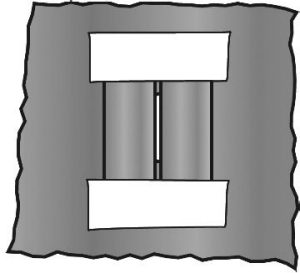By Sherri C Rukes
Introduction
Sunlight reaches the earth as white light, which is made up of all the rainbow colors. Rainbow colors are red, orange, yellow, green, blue, indigo, and violet. It is easy to remember them by using the name “Roy G. Biv.” A rainbow is a spectrum of visible light.
Each color has a different wavelength. To separate white light into these colors, the light needs to pass through a material that “bends” it. This bending of the light is called refraction. When you see a rainbow, the light from the sun is actually passing through water drops in the air, which bends the light and splits it into its different colors. A scientific tool that can do the same thing is called a spectroscope (early spectroscopes used prisms).
You can make your own spectroscope by following the instructions shown below!
Safety Suggestions
- Be careful handling scissors (if used)
Materials
- Paper towel tube (or any tube of a similar size, such as PVC piping or a shipping tube)
- Aluminum foil: two 4″×4″ pieces and two 1″× 3″ pieces
- Masking tape
- Diffraction grating (single axis, approximately 1″ square). This is a thin plastic film with hundreds of tiny lines etched into it and can be bought online.
- Light sources, such as fluorescent bulbs, incandescent lights, streetlamps, LED lights, and neon lights
Procedure
- Assemble the diffraction grating end first. Take one of the 4″ × 4″ pieces of foil and tear or cut a small hole in the center of it — a hole that is smaller than your piece of diffraction grating. Make a hole between the size of a nickel and a dime. (An easy way is to fold the foil square in half, then fold it in half again, in the other direction. Tear off the corner that is at the center of the foil and unfold it.)
Center this foil-mounted grating over one end of the tube, tape side in, and tape it to the outside of the tube at its edges.
Now look through the tube at lights in the room to see the effects of the grating before the spectroscope is finished.
- Assemble the slit end on the table. Take the other 4″ × 4″ piece of foil and make a hole in the center as before. The hole's diameter should be smaller than the tube's, to avoid gaps and tears.
Carefully fold both of the 1″ × 3″ pieces of foil in half along the length. Make a sharp crease at the fold of each. Lay them over the hole in the larger piece of foil so that their creased edges face each other with a very small gap or slit between them (no more than the width of a toothpick, or the thickness of a coin). Tape the two creased pieces of foil over the hole and do not cover the slit with tape.
Place the foil-mounted slit over the open end of the tube, tape the side in, and wrap the foil around the end of the tube to hold it in place. Don’t tape the slit end to the tube, but you may secure it with a rubber band if you wish. The slit allows you to select what you want to look at and adjust the size and shape of its spectrum.
- Hold the spectroscope so that you can look through the diffraction grating end. Point the slit end of the spectroscope toward a light source. Look for a rainbow in the spectroscope (which may be a little bit off to the side, or above or below the diffraction grating).
While still pointing the spectroscope at the light source, and holding the tube steady, twist the slit around until the rainbow is as tall or large as you can make it. When it is as tall and large as possible, tape it in place.
What did you observe?
Do all light sources produce a complete rainbow? Let’s find out. Experiment with different light sources and record the colors of their spectrum.
| Type of light | Colors observed | ||
| Fluorescent light | |||
| Incandescent light | |||
| Streetlamps | |||
| Holiday lights - LED | |||
| Neon sign |
How does it work? / Where's the chemistry?
Light is a mixture of different wavelengths. A spectroscope is a tool that splits up light into its different wavelengths, which we see as different colors. The diffraction grating you used has a series of lines that are very close together. When light from the slit hits these lines, the light is bent and separates into different wavelengths. Not all light sources give off a full “rainbow” spectrum. Each element produces a unique spectrum, just like your fingerprints. Scientists can tell which elements make up a star by looking at the colors of the spectrum it produces.
References
- Afterschool Universe program Leader’s Manual
- Educational Innovations, Inc. — a source for diffraction gratings and other science teaching tools
Sherri C. Rukes is an Honors and AP Chemistry Teacher at Libertyville High School in Libertyville, Illinois.






